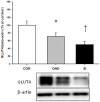GLUT4 and UBC9 protein expression is reduced in muscle from type 2 diabetic patients with severe insulin resistance
- PMID: 22114711
- PMCID: PMC3218059
- DOI: 10.1371/journal.pone.0027854
GLUT4 and UBC9 protein expression is reduced in muscle from type 2 diabetic patients with severe insulin resistance
Abstract
Aims: Subgroups of patients with type 2 diabetes mellitus demand large insulin doses to maintain euglycemia. These patients are characterized by severe skeletal muscle insulin resistance and the underlying pathology remains unclear. The purpose of this study was to examine protein expression of the principal glucose transporter, GLUT4, and associated proteins in skeletal muscle from type 2 diabetic patients characterized by severe insulin resistance.
Methods: Seven type 2 diabetic patients with severe insulin resistance (mean insulin dose 195 IU/day) were compared with seven age matched type 2 diabetic patients who did not require insulin treatment, and with an age matched healthy control group. Protein expression of GLUT4 and associated proteins was assessed in muscle and fat biopsies using standard western blotting techniques.
Results: GLUT4 protein expression was significantly reduced by ∼30 pct in skeletal muscle tissue from severely insulin resistant type 2 diabetic subjects, compared with both healthy controls and type 2 diabetic subjects that did not require insulin treatment. In fat tissue, GLUT4 protein expression was reduced in both diabetic groups. In skeletal muscle, the reduced GLUT4 expression in severe insulin resistance was associated with decreased ubiquitin-conjugating enzyme 9 (UBC9) expression while expression of GLUT1, TBC1D1 and AS160 was not significantly different among type 2 diabetic patients and matched controls.
Conclusions: Type 2 diabetic patients with severe insulin resistance have reduced expression of GLUT4 in skeletal muscle compared to patients treated with oral antidiabetic drugs alone. GLUT4 protein levels may therefore play a role in the pathology behind type 2 diabetes mellitus among subgroups of patients, and this may explain the heterogeneous response to insulin treatment. This new finding contributes to the understanding of the underlying mechanisms for the development of extreme insulin resistance.
Conflict of interest statement
Figures



References
-
- Koranyi LI, Bourey RE, Vuorinen-Markkola H, Koivisto VA, Mueckler M, et al. Level of skeletal muscle glucose transporter protein correlates with insulin-stimulated whole body glucose disposal in man. Diabetologia. 1991;34:763–765. - PubMed
-
- Shepherd PR, Kahn BB. Glucose transporters and insulin action--implications for insulin resistance and diabetes mellitus. N Engl J Med. 1999;341:248–257. - PubMed
-
- Shi J, Kandror KV. Sortilin is essential and sufficient for the formation of Glut4 storage vesicles in 3T3-L1 adipocytes. Dev Cell. 2005;9:99–108. - PubMed
Publication types
MeSH terms
Substances
LinkOut - more resources
Full Text Sources
Medical
Miscellaneous

